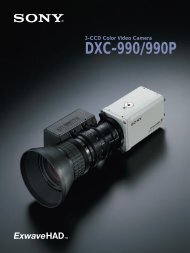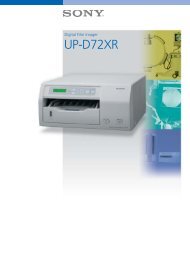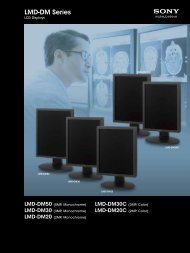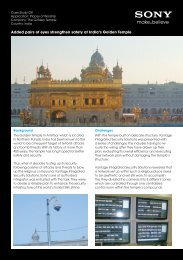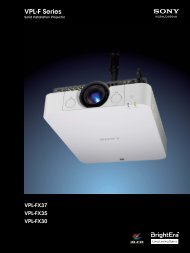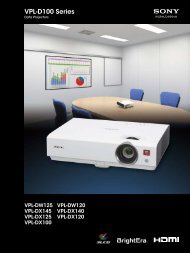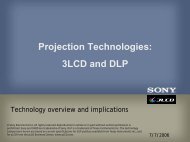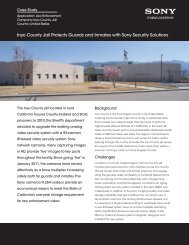SRX-R320 LMT-300 STM-100
SRX-R320 LMT-300 STM-100
SRX-R320 LMT-300 STM-100
You also want an ePaper? Increase the reach of your titles
YUMPU automatically turns print PDFs into web optimized ePapers that Google loves.
<strong>SRX</strong>-<strong>R320</strong><br />
4K Digital Cinema Projector<br />
<strong>LMT</strong>-<strong>300</strong><br />
Media Block<br />
<strong>STM</strong>-<strong>100</strong><br />
Theater Management System
The Standard of 4K Digital Cinema -<br />
Sony’s Integrated Projection System<br />
2
World-first DCI Specification-compliant<br />
4K Digital Cinema Projection System<br />
Combines a Cinema Server and 4K Projector<br />
In 2009, Sony introduced an ultra-high-resolution 4K digital cinema projection<br />
system combining an <strong>SRX</strong>-<strong>R320</strong> 4K SXRD projector and an <strong>LMT</strong>-<strong>300</strong> Media Block.<br />
Since its sensational debut, this complete system has rapidly acquired a huge<br />
reputation among a range of users worldwide due to its advanced features and<br />
functionalities specifically designed for digital cinema applications.<br />
In March 2011, Sony announced that this system was the world’s first<br />
to successfully complete the full range of compliance tests for the DCI<br />
specification - the Digital Cinema Initiatives, LLC (known as DCI) is a joint venture<br />
of six major Hollywood studios*. As a result, this DCI specification-compliant<br />
system is now called Sony’s Integrated Projection System.<br />
The <strong>SRX</strong>-<strong>R320</strong> projector is equipped with three Silicon X-tal Reflective Display<br />
(SXRD) devices, delivering an amazing resolution of 4096 x 2160 pixels (H x V)<br />
- more than four times the resolution of full HDTV (1920 x 1080), and achieving a<br />
high contrast ratio of more than 2000:1.<br />
The <strong>LMT</strong>-<strong>300</strong> Media Block is a digital cinema server that incorporates hard disk<br />
drives (HDDs) with a large storage capacity of approximately 1.7 TB and adopts<br />
a reliable RAID (Redundant Array of Inexpensive Disks) system. It can play back<br />
DCI DCP (Digital Cinema Package) files and allows the <strong>SRX</strong>-<strong>R320</strong> projector to<br />
show digital cinema programs. Another unique feature of the <strong>LMT</strong>-<strong>300</strong> is its<br />
Screen Management System function, which is equipped as standard and can<br />
provide a variety of screen-management operations such as show scheduling,<br />
communication with other theater control systems (eg, lighting and curtains),<br />
and setup and maintenance of the projector.<br />
Moreover, this projection system offers optional <strong>STM</strong>-<strong>100</strong> Theater Management<br />
System software that allows<br />
theater staff to efficiently<br />
manage multiple auditoriums<br />
from a central PC connected to<br />
the theater LAN.<br />
With extremely high resolution,<br />
outstanding security, and<br />
operational versatility, Sony’s<br />
Integrated Projection System<br />
based on the <strong>SRX</strong>-<strong>R320</strong> 4K<br />
projector is a perfect choice for<br />
digital cinema applications.<br />
* The six major Hollywood studios are Walt<br />
Disney Company, Sony Pictures Entertainment,<br />
Inc., 20th Century Fox, Paramount Pictures<br />
Corporation, Warner Bros. Entertainment Inc.,<br />
and Universal Studios Inc.<br />
<strong>SRX</strong>-<strong>R320</strong> with LKRA-003 Touch Panel Monitor attached<br />
3
4<br />
System Advantages/Features<br />
4K Resolution<br />
Historically, the movie theater experience has always<br />
exceeded that achieved by home entertainment systems.<br />
The advent of HDTV (1920 horizontal pixels) and technical<br />
improvements in home theater equipment have stimulated<br />
the movie industry to think further ahead into the future.<br />
Meanwhile, the Hollywood movie studios have jointly<br />
agreed on standardizing 4K (4096 horizontal pixels) and<br />
2K (2048 horizontal pixels) as the next-generation digital<br />
movie distribution and projection standards. Creating<br />
movies in 4K protects the future value of the content, and<br />
also provides a significant benefit to the theater audience.<br />
In recent years, stadium-type seating is becoming<br />
increasingly popular among modern cinema complexes.<br />
By sitting closer to the screen, the audience can enjoy a<br />
more immersive visual experience. However, those sitting<br />
in the front rows may witness pixel artifacts when the<br />
resolution provided by the projection system is not sufficient<br />
to fill the screen size. The <strong>SRX</strong>-<strong>R320</strong> provides true 4K output,<br />
which reproduces the full detail of 4K content thanks to<br />
the 4K SXRD panels, 4K internal signal processing, and<br />
4K-compatible optical system. Besides, since the <strong>SRX</strong>-<strong>R320</strong><br />
provides four times the resolution of 2K projectors, the visual<br />
quality of 2K and HD content is also improved over those<br />
provided by native 2K and HD-resolution projectors.<br />
Screen<br />
1<br />
1<br />
2<br />
2<br />
3<br />
4<br />
3<br />
5<br />
4<br />
5<br />
7<br />
8<br />
Cineplex<br />
(Stadium seating)<br />
10<br />
9<br />
Traditional theater<br />
7<br />
8<br />
9<br />
10
High 2000:1 Contrast Ratio<br />
The <strong>SRX</strong>-<strong>R320</strong> offers a high contrast ratio of more than<br />
2000:1 through the use of Sony’s unique SXRD device. The<br />
SXRD device itself achieves a contrast ratio of over 4000:1.<br />
This stunning picture quality makes the <strong>SRX</strong>-<strong>R320</strong> ideal for<br />
applications in which dynamic range is essential.<br />
The high contrast ratio has been achieved through two key<br />
technologies – the ‘normally black mode’ system and an<br />
extremely thin liquid crystal cell gap.<br />
Xenon Lamp Provides Highly Bright<br />
and Pure Light Source<br />
The <strong>SRX</strong>-<strong>R320</strong> provides a high brightness on a wide screen<br />
using a Xenon lamp. A Xenon lamp provides pure, superb<br />
color tonal reproduction essential to meeting the stringent<br />
requirements of digital cinema. Xenon lamps, which<br />
are designed for the <strong>SRX</strong>-<strong>R320</strong> and available from lamp<br />
manufacturers, satisfy the wide color range required for<br />
digital cinema by dispersion at a very flat and wide light<br />
spectrum.<br />
Available Xenon Lamps<br />
Sony-recommended Xenon lamps for the <strong>SRX</strong>-<strong>R320</strong> are<br />
available from lamp manufacturers such as USHIO, OSRAM,<br />
and PHILIPS. For detailed information on the lamps, please<br />
contact your nearest Sony or lamp manufacturer’s office.<br />
Variety of High-quality Lenses<br />
Three optional zoom lenses are available for the <strong>SRX</strong>-<strong>R320</strong>.<br />
All lenses utilize very large image circles that contribute to<br />
minimizing the optical vignetting that typically occurs on<br />
projector lenses, and to obtaining the highest possible values<br />
of MTF (Modulation Transfer Function). With these features,<br />
the optical systems of the <strong>SRX</strong>-<strong>R320</strong> have the capacity to<br />
reproduce resolutions higher than 4K, which is necessary to<br />
project 4K content exactly at 4K resolution. In addition, these<br />
lenses are designed to minimize chromatic aberrations using<br />
Sony’s accumulated technical knowledge.<br />
LKRL-Z211<br />
LKRL-Z214<br />
Variety of Interfaces<br />
The <strong>SRX</strong>-<strong>R320</strong> supports a wide variety of signal formats including<br />
the 12-bit X’Y’Z’ signal that is stipulated in the DCI specification.<br />
10-bit 4:4:4 RGB and 10-bit 4:2:2 YPbPr signal formats are also<br />
supported for playback of other alternative content.<br />
n Two channels of SRLV (Sony original multi-pin interface),<br />
which are used for connection to the <strong>LMT</strong>-<strong>300</strong> Media Block<br />
(for 4K projection: 4K DCP).<br />
n A DVI (HDCP) interface that accepts DVI (HDCP) signals for<br />
up to 2048 x 1080 at 60 FPS (for 2K projection).<br />
n A dual-link HD-SDI/DC-SDI input* that accepts any of the<br />
following signals:<br />
• For HD projection: SMPTE 372M dual-link HD-SDI (4:4:4), or<br />
SMPTE 292M HD-SDI (4:2:2)<br />
• For 2K projection: Dual-link DC-SDI (RGB 4:4:4), DC-SDI<br />
(YPbPr 4:2:2), or 12-bit X’Y’Z’ signals (4:4:4)<br />
* To support this input, the optional LKRI-003 board is required.<br />
LKRL-Z219<br />
5
Operational Features<br />
3D Projection Lens Unit<br />
Attaching the 3D projection lens unit to its lens mount, the<br />
SXR-<strong>R320</strong> can deliver crisp 3D images*. It allows full 2K<br />
resolution for the left and right eyes simultaneously, resulting<br />
in a high-brightness, high-quality stereoscopic cinema<br />
presentation that offers more faithful reproduction of motion<br />
in 3D.<br />
* To produce 3D images on a screen, 3D systems available from 3D system<br />
integrators are required. For detailed information on the 3D systems, please<br />
contact your nearest Sony office.<br />
<strong>SRX</strong>-<strong>R320</strong> with 3D projection lens unit attached<br />
Anamorphic Lens<br />
When projecting digital cinema content created in the<br />
CinemaScope format (4096 x 1716 pixels), the <strong>SRX</strong>-<strong>R320</strong><br />
cannot use all of the 4096 x 2160 pixels available for the<br />
4K SXRD device. To improve this inefficiency, the optional<br />
LKRL-A001 Anamorphic Lens with Lens Changer Unit*<br />
was developed. When CinemaScope images (4096 x<br />
1716 pixels) are input, the <strong>SRX</strong>-<strong>R320</strong> extends them in a<br />
longitudinal direction via the projector’s image-processing<br />
function, which effectively uses all the pixels of the SXRD<br />
device. The LKRL-A001 attached** in front of the projector’s<br />
6<br />
lens extends the images in a transverse direction, so that<br />
the aspect ratio of the images projected on a screen<br />
can be restored to its original 2.39:1. This can increase<br />
the brightness level of the images on the screen by<br />
approximately 20%, allowing for the projector to provide a<br />
high brightness on large screens.<br />
The LKRL-A001 includes a lens-changer function that can<br />
set the anamorphic lens not to be in use manually. This<br />
function allows for the <strong>SRX</strong>-<strong>R320</strong> to accept digital cinema<br />
content created in the Flat format (3996 x 2160 pixels),<br />
without dismounting the LKRL-A001 unit from the projector.<br />
1716 Pixels<br />
<strong>SRX</strong>-<strong>R320</strong> Projector<br />
4096 Pixels 4096 Pixels<br />
Digital Cinema Content<br />
in CinemaScope Format<br />
4K SXRD Device<br />
LKRL-A001<br />
CinemaScope Image on Screen<br />
(aspect ratio of 2.39 :1 )<br />
* The LKRL-A001 supports 2D projection lenses. For detailed information,<br />
please contact your nearest Sony office.<br />
** To attach the LKRL-A001 to the projector, lens support stays are required.<br />
For detailed information, please contact your nearest Sony office.<br />
<strong>SRX</strong>-<strong>R320</strong> with LKRL-A001 attached;<br />
anamorphic lens not in use<br />
2160 Pixels
Anamorphic Mode Function<br />
The <strong>SRX</strong>-<strong>R320</strong> allows squeezed images (16:9 or 1.896:1) to be<br />
changed to 2.39:1 un-squeezed images. This can be done<br />
electrically without an anamorphic lens.<br />
Color Space Conversion (CSC)<br />
Function<br />
The <strong>SRX</strong>-<strong>R320</strong> features a Color Space Conversion (CSC)<br />
function, which helps users easily adjust the projector’s<br />
color space to that which is defined in the DCDM (Minimum<br />
D-Cinema Color Gamut) or ITU-R BT.709. The target color<br />
gamut parameters required to meet the DCDM or ITU-R<br />
BT.709 standards can also be applied to the projector<br />
with this function. The internal test generator simplifies<br />
adjustment and lets the operator align the projector in<br />
minutes.<br />
Gamma Curve Selection<br />
The <strong>SRX</strong>-<strong>R320</strong> provides three preset gamma curve values.<br />
Users can select an optimum value from 1.8, 2.2, and 2.6<br />
according to the desired color tone.<br />
Lens Shift Function<br />
The <strong>SRX</strong>-<strong>R320</strong> is equipped with a lens shift function that<br />
allows projected images to be moved up and down or<br />
from side to side. This lens shift function can be operated<br />
manually via the finger screws incorporated on the<br />
projector’s unit. Using this function, the position of the<br />
projected images can be moved vertically and horizontally.<br />
Keystone Masking<br />
To compensate for keystone distortion, which typically<br />
occurs when the projector is not installed directly in front of<br />
the screen, the <strong>SRX</strong>-<strong>R320</strong> has an image-masking function.<br />
To determine the best position for the masking, this function<br />
allows users to set further two points in addition to the four<br />
corner points, which is particularly useful when projecting<br />
onto a curved screen.<br />
Select four corner positions to mask the area outside the perimeter.<br />
Zoom/Focus Memory Function<br />
Masked area<br />
For curved screens, select two positions at the apex of the curve,<br />
one at the top and one at the bottom of the screen.<br />
The <strong>SRX</strong>-<strong>R320</strong> is equipped with zoom and focus memory<br />
functions that make it easy to switch the projection<br />
between two types of aspect ratios.<br />
When used with an optional zoom lens - such as the<br />
LKRL-Z211, LKRL-Z214, or LKRL-Z219 - the zoom and focus<br />
positions for the 1.85:1 Flat screen format and 2.39:1<br />
CinemaScope can be stored in the projector’s memory and<br />
then instantly recalled from there. This allows for full-screen<br />
display regardless of the aspect ratio. An electronic vertical<br />
alignment feature is included in the same memory to<br />
compensate for vertical changes in the image, should the<br />
projector be mounted at a downwards angle.<br />
7
Maintenance and Security Features<br />
Easy Maintenance of Luminance<br />
Level<br />
During long periods of usage, users commonly have to<br />
adjust the luminance level of their projector, as Xenon<br />
lamps typically get darker over time. The <strong>SRX</strong>-<strong>R320</strong> has a<br />
convenient function to help users know when to make such<br />
adjustments. It allows users to set a standard luminance<br />
level, and displays an alert message on the LCD screen of<br />
the projector when the value changes from the standard<br />
level. With this feature, proper and timely maintenance of<br />
the luminance level can be performed.<br />
Automatic Lamp Power Calibration<br />
Function<br />
When switching the aspect ratio of projection from<br />
CinemaScope to VistaVision and vice versa, the luminance<br />
levels happen to change. To maintain a constant<br />
luminance level even after making these changes, the<br />
<strong>SRX</strong>-<strong>R320</strong> can automatically calibrate the luminance level<br />
by controlling the lamp output power.<br />
Air-flow Sensor for Reliable Cooling<br />
The <strong>SRX</strong>-<strong>R320</strong> has a chimney on top of the unit that expels<br />
warm air, thereby keeping the projector unit cool. The<br />
chimney has an air-flow sensor that measures the amount<br />
of discharged air. When the projector is powered on from<br />
Standby mode, the air-flow sensor operates automatically.<br />
If the value does not reach a normal level, an alert<br />
message is displayed on the projector’s LCD screen.<br />
Thanks to this function, the operator can immediately<br />
take proactive maintenance action, allowing for reliable<br />
projector cooling.<br />
Power Supply and Control of<br />
External Ventilation Fan<br />
To efficiently discharge warm air from the unit, the chimney<br />
of the <strong>SRX</strong>-<strong>R320</strong> projector must be connected to an exhaust<br />
duct with a ventilation fan. For optimum reliability and<br />
effectiveness, the projector supports an Interlock interface,<br />
which enables the <strong>SRX</strong>-<strong>R320</strong> to operate this external<br />
ventilation fan. The projector can supply power to the fan<br />
and control its operation – the fan works when the projector<br />
is in Lamp ON mode or Standby ON mode.<br />
8<br />
Anti-tamper System<br />
The <strong>SRX</strong>-<strong>R320</strong> is designed to be highly secure. It does<br />
not have screw holes, and requires physical keys to open<br />
the enclosure. This body structure meets the anti-tamper<br />
requirement of the DCI. Even if the enclosure is opened<br />
with the physical keys, anti-tamper sensors will trigger the<br />
<strong>LMT</strong>-<strong>300</strong> Media Block to immediately start recording logs for<br />
further safety. In this case, the projector also deletes Key<br />
Delivery Messages (KDM) automatically, so that DCP files<br />
cannot be played back.<br />
<strong>SRX</strong> Controller Software<br />
The <strong>SRX</strong> Controller software* is a convenient tool for system<br />
integrators to set up and maintain the <strong>SRX</strong>-<strong>R320</strong>. This runs<br />
on a PC** connected to the projector via the RS-232C<br />
interface, and features intuitive GUIs that enable easy<br />
setup and adjustment of the projector. A comprehensive<br />
range of setup parameters including input configurations,<br />
colorimetry controls, installation adjustments, and<br />
maintenance settings can be controlled via this software.<br />
For example, it allows operators to easily verify a lamp’s<br />
operating time. Plus, the versatile projector functions<br />
such as Squeeze Mode, Color Space Conversion (CSC),<br />
and Zoom/Focus Memory can also be controlled via this<br />
software.<br />
* For detailed information on availability of the <strong>SRX</strong> Controller software, please<br />
contact your nearest Sony office.<br />
** System requirements for the <strong>SRX</strong> Controller software: Microsoft ® Windows ®<br />
XP Professional and Windows 7. Supported OS languages are English and<br />
Japanese only.
SXRD Technologies<br />
In addition to its extreme resolution and high contrast,<br />
the SXRD device used in the <strong>SRX</strong>-<strong>R320</strong> projector<br />
has the following remarkable<br />
technological features:<br />
‘Normally Black Mode’ System<br />
In every type of projection system, displaying absolute<br />
black is a major issue – as this helps to achieve a high<br />
contrast ratio. In other words, the contrast ratio of a projector<br />
depends on how effectively the light from the source can be<br />
blocked, so it does not leak through the display device.<br />
All Liquid Crystal Display (LCD) devices control the amount<br />
of light to be projected by applying an electric field to the<br />
liquid crystal gap. In typical LCD devices, black is produced<br />
when an electric field is applied across the liquid crystal<br />
cell gap. However, molecules near the surface of the<br />
glass substrate may not be accurately controlled due to<br />
the influence of the alignment film. This is not an issue for<br />
bright images but, when displaying dark images, light may<br />
tend to leak from the LCD device, since the molecules near<br />
the surface are less accurately controlled. This results in a<br />
creamy black instead of a deep black.<br />
The SXRD device does not exhibit these characteristics.<br />
This is because the ‘normally black mode’ system displays<br />
black when the electric field is not applied and, because all<br />
molecules are in the correct alignment, the polarized light<br />
alignment is also optimized. The direct result is a far deeper<br />
black level, leading to a high contrast ratio.<br />
Thin Liquid Crystal Cell Gap<br />
Another important factor allowing for the high contrast of the<br />
<strong>SRX</strong>-<strong>R320</strong> is the SXRD device’s ultra-thin cell gap of less than<br />
2 micrometers. With conventional ‘vertically aligned liquid<br />
SXRD Cross-Section Diagram<br />
Glass Substrate<br />
Liquid Crystal<br />
High-Density Pixel Pitch 8.5 µm<br />
• 4 x Full-HDTV (4096 H x 2160 V pixels)<br />
Thin Cell Gap (2.0 µm) Spacer-less<br />
• Short response time < 2.5 ms (for both rise and fall)<br />
• High Device Contrast ratio 4000 : 1<br />
Light<br />
Inorganic<br />
Alignment Layer<br />
• High reliability<br />
Silicon Backplane<br />
crystal’ systems, a thin cell gap could not be achieved. Sony<br />
has overcome this difficulty through the use of innovative<br />
planarization technology in the silicon backplane structure<br />
and an advanced silicon wafer-based assembly process.<br />
The SXRD device also adopts a structure that does not use<br />
’spacers’. These are columns found in conventional reflective<br />
liquid crystal devices to maintain a constant gap between<br />
the liquid cell floor and the top of the device. Spacers tend<br />
to both scatter and reflect light, which can impair highcontrast<br />
pictures. In the spacer-less SXRD device, these<br />
artifacts are no longer seen.<br />
Short Response Time<br />
The thin cell gap structure in SXRD devices also contributes<br />
to an ultra-fast response time of 2.5 milliseconds (for both<br />
rise and fall). The SXRD device reacts promptly to an<br />
instantaneous change of picture content, enabling SXRDbased<br />
projectors to display smooth motion. Consequently,<br />
the <strong>SRX</strong>-<strong>R320</strong> virtually eliminates motion blur; a particularly<br />
significant benefit when presenting content that includes<br />
fast-moving objects.<br />
Thermal Management by Peltier Device<br />
The <strong>SRX</strong>-<strong>R320</strong> adopts an advanced thermal management<br />
system that combines a Peltier device and a thermal<br />
sensor. The Peltier device is placed at the back of the<br />
SXRD device to cool or heat the panel by applying current.<br />
The thermal sensor attached to the panel measures the<br />
panel temperature and feeds back this data to the Peltier<br />
device so that the temperature can be precisely controlled.<br />
Thanks to this system, the SXRD device is maintained under<br />
temperature conditions that optimize performance.<br />
12-bit SXRD Driver<br />
The <strong>SRX</strong>-<strong>R320</strong> utilizes a 12-bit display panel driver for<br />
reproducing extremely natural images.<br />
Aluminium Pad<br />
Narrow Inter-Pixel<br />
Spacing (0.35 µm)<br />
• High fill factor<br />
• High reflectivity<br />
9
Digital Cinema Server – <strong>LMT</strong>-<strong>300</strong> Media Block<br />
The <strong>LMT</strong>-<strong>300</strong> Media Block is a digital cinema server with a large storage capacity and high reliability. It can be<br />
seamlessly integrated into the chassis of the <strong>SRX</strong>-<strong>R320</strong> projector, allowing for a highly secure DCI specificationcompliant<br />
Integrated Projection System. The <strong>LMT</strong>-<strong>300</strong> can handle DCI DCP (Digital Cinema Package) files<br />
that consist of picture, audio, and subtitle data files, and that are wrapped into an MXF (Material eXchange<br />
Format) file. It can play back the DCP file by using advanced<br />
processing to decrypt and decode the picture data, and then send<br />
it to the projector over a secure multi-pin connection system.<br />
Moreover, the <strong>LMT</strong>-<strong>300</strong> incorporates the Screen Management System<br />
(SMS) function, which lets operators manage all of the devices<br />
necessary for digital cinema presentation from one location.<br />
10<br />
DCP<br />
HDD, etc<br />
Center<br />
Storage<br />
TMS Controller<br />
with <strong>STM</strong>-<strong>100</strong><br />
/SMS Controller<br />
with SNS-C software*<br />
Secured Contents<br />
from Distributors<br />
TMS Server<br />
with <strong>STM</strong>-<strong>100</strong><br />
Auditorium B<br />
Auditorium C<br />
Firewall<br />
Theater LAN<br />
LKRA-003<br />
Touch Panel<br />
Monitor<br />
(Projectionist<br />
Terminal)<br />
Large Storage Capacity and<br />
Reliable RAID System<br />
The <strong>LMT</strong>-<strong>300</strong> incorporates HDDs with a large storage<br />
capacity of approximately 1.7 TB. It employs a Modified<br />
RAID 6 (Redundant Array of Inexpensive Disks) system that<br />
allows for highly reliable digital cinema presentation.<br />
Decryption and Unwrapping of<br />
DCP Files<br />
The <strong>LMT</strong>-<strong>300</strong> can decrypt DCP files that have been encrypted<br />
using the AES (Advanced Encryption Standard FIPS 197). It<br />
can also unwrap individual picture, audio, and subtitle data<br />
files for processing that are encoded within the MXF file.<br />
Picture and Subtitle<br />
The <strong>LMT</strong>-<strong>300</strong> can decode JPEG 2000 picture data in real time<br />
for playback, regardless of whether the file was encoded at<br />
2K or 4K resolution. Subtitles in Timed-Text/XML or PNG/XML<br />
format can be overlaid onto picture data before it is sent to<br />
the projector.<br />
System Configuration Example<br />
USB2.0<br />
DCP<br />
<strong>SRX</strong>-<strong>R320</strong><br />
<strong>LMT</strong>-<strong>300</strong><br />
HDD, etc<br />
Control<br />
UPS<br />
Pedestal<br />
GPIO<br />
AES/EBU<br />
Digital Audio<br />
Audio Control<br />
* For detailed information on availability of the SMS-C software, please contact your nearest Sony office.<br />
Audio<br />
Auditorium A<br />
Automation System<br />
Sound Processor<br />
Light Controller<br />
Curtain Controller<br />
The <strong>LMT</strong>-<strong>300</strong> transcodes audio DCP files into AES/EBU digital<br />
audio signals, and then outputs them from two audio output<br />
connectors (D-sub 25-pin) to external audio processors such<br />
as Dolby ® sound processors. The audio output 1 and audio<br />
output 2 can support up to 8 and 16 channels, respectively.<br />
The timing of the audio output can be adjusted for<br />
complete synchronization with the picture, and any channel<br />
can be routed to any output to simplify installation.<br />
Log Creation<br />
The <strong>LMT</strong>-<strong>300</strong> can generate logs to record certain<br />
information – such as the number of times a movie has<br />
been played – which is a DCI requirement for secure<br />
content control.<br />
Ingest of DCP Files During Playback<br />
DCP files can be ingested to the <strong>LMT</strong>-<strong>300</strong>, even while<br />
playing a movie.
Screen Management System<br />
As standard, the <strong>LMT</strong>-<strong>300</strong> incorporates the Screen<br />
Management System (SMS). Thanks to this SMS function,<br />
the operator can perform a variety of functions required<br />
for digital cinema presentation via the touch-panel screen<br />
of a projectionist terminal attached to the projector. This<br />
SMS function can also be operated remotely from a PC*<br />
connected to the theater network. In addition, the SMS<br />
can be seamlessly integrated with other theater systems<br />
that have the optional <strong>STM</strong>-<strong>100</strong> Theater Management<br />
System software installed, as well as third-party auditorium<br />
automation systems.<br />
The SMS of the <strong>LMT</strong>-<strong>300</strong> satisfies the requirements of the<br />
DCI specifications version 1.2 for screen management and<br />
security.<br />
* To support the SMS controller functions, the SMS controller software must<br />
be installed on the PC. For detailed information on its availability, please<br />
contact your nearest Sony office.<br />
Screen Management Functions Operated<br />
by a Projectionist Terminal:<br />
• DCP ingest/registration and DCP management<br />
• Key Delivery Message (KDM) registration and key<br />
management<br />
• Show Play List (SPL) creation and management<br />
• Show schedule viewing<br />
• Playback control<br />
• Execution of SPLs<br />
• Device configuration<br />
• Device monitoring<br />
• Status monitoring: collect status information from<br />
the projector and Media Block; report status at<br />
pre-configured intervals<br />
• Monitoring of cavity security status from Media Block<br />
• Automation system interface<br />
• Projector Power On/Standby control<br />
• Lamp Power On/Off control<br />
• Adjustment of lamp power values<br />
• Adjustment of the lamb bulb’s z-axis<br />
• Lamp serial code input function when installing a new<br />
lamp bulb<br />
• Adjustment of a registration gap<br />
• Display of filter information and reset timer<br />
• Initialization of Cavity Security System (CSS)<br />
• Content information display: title, aspect ratio,<br />
and KDM validity<br />
Menu window of LKRA-003 Touch Panel Monitor<br />
(projectionist terminal)<br />
Setup and Maintenance Functions by an SMS<br />
Control PC:<br />
• Auditorium setup<br />
• Log retrieval: including log filtering and secondary log<br />
distribution<br />
• Interface (XML/HTTPS) to external Theater Management<br />
System (TMS)<br />
• Automation system interface<br />
• Security functions<br />
Enclosure Status Light Management Functions:<br />
• Monitors and aggregates status of all system<br />
components<br />
• Sends aggregated status information to the status light of<br />
the enclosure<br />
11
Theater Management System – <strong>STM</strong>-<strong>100</strong><br />
The <strong>STM</strong>-<strong>100</strong> Theater Management System (TMS) is one<br />
of the key digital cinema software applications that can<br />
provide efficient centralized management of theater<br />
operations – including schedule management, content<br />
data management, and status monitoring – allowing<br />
cinema complexes to streamline routine theater operations.<br />
The <strong>STM</strong>-<strong>100</strong> provides the following range of functions:<br />
Centralized Monitoring of Auditoriums<br />
Functions:<br />
• Monitoring of auditorium and projector status<br />
• Emergency operation of show (Stop, Pause, Resume,<br />
Resume with latency time)<br />
• Display of auditorium details (Projector status, DCP ingest<br />
schedule, Show details, Error/Warning)<br />
• Indication of status information such as fatal error/warning<br />
and creation/exporting of error logs<br />
Schedule Management Functions:<br />
• Daily and weekly schedule view with zoom function<br />
• Import of schedule data from POS/Ticket system<br />
• Automatic update of latest schedule from POS/Ticket<br />
system<br />
• Automatic allocation of Show Play List (SPL) with POS<br />
schedule update<br />
• Easy schedule creation by drag-and-drop operation<br />
• Automatic creation of To-do List with priority (unassigned<br />
SPL, lack of DCP/KDM, etc) for schedule making<br />
12<br />
Menu windows of <strong>STM</strong>-<strong>100</strong><br />
Creation of SPL Functions:<br />
• SPL creation and management<br />
• Composition Play List (CPL) grouping functions to combine<br />
multiple compositions (content programs such as trailers)<br />
• Customized SPL template with Cue (output trigger)<br />
• Blank time insertion into SPL<br />
• Automatically adjustable cue setting<br />
• Manual transfer of SPL to auditorium for test screening<br />
• Content search/sort function with multiple parameters<br />
such as title and content group<br />
• Flexible control of scheduled/manual playout<br />
DCP/KDM Management Functions:<br />
• Centralized DCP/KDM management and status monitoring<br />
• Display of hierarchical DCP/KDM list with automatic linkage<br />
• Display of urgent level for necessary DCP/KDM ingestion to<br />
local storage<br />
• KDM validity status indication<br />
• Display of capacity of central storage and local storage<br />
• Automatic and manual ingest of DCP/KDM to auditorium<br />
• Automatic and manual deletion of DCP/KDM<br />
• Content transfer between multiple sources including library<br />
servers and local servers<br />
• Management of multiple library servers within theater<br />
network<br />
Other Valuable Features<br />
• Interface with people directory systems<br />
• Interface with external system via GPIO<br />
• Management of third-party’s servers under a single TMS
Dimensions<br />
<strong>SRX</strong>-<strong>R320</strong><br />
<strong>LMT</strong>-<strong>300</strong><br />
699 (27 5/8)<br />
131 (5 1/4)<br />
8 (11/32)<br />
580 (22 7/8)<br />
89 (3 5/8)<br />
21 (27/32)<br />
222 (8 3/4) 590 (23 1/4)*<br />
ø198 (7 7/8)<br />
1250 (49 1/4)<br />
443 (17 1/2)<br />
482 (19)<br />
465 (18 3/8)<br />
443 (17 1/2)<br />
545 (21 1/2)**<br />
Area necessary for<br />
cooling of <strong>LMT</strong>-<strong>300</strong><br />
30.5 (1 1/4)<br />
547.3 (21 5/8)<br />
131 (5 1/4)<br />
174 (6 7/8)<br />
31 (1 1/4)<br />
726 (28 5/8) 88 (3 1/2)<br />
241 (9 1/2)<br />
(for LKRL-Z214)<br />
19 (3/4)* 9 (3/8)**<br />
212 (8 3/8)*<br />
* Barycentric position of <strong>SRX</strong>-<strong>R320</strong> with LKRL-Z214<br />
** Barycentric position of <strong>SRX</strong>-<strong>R320</strong> with LKRL-Z214 and <strong>LMT</strong>-<strong>300</strong><br />
580 (22 7/8)<br />
154 (6 1/8)<br />
19 (3/4)* 9 (3/8)**<br />
609 (24)<br />
699 (27 5/8)<br />
64 (2 5/8)<br />
344 (13 5/8)**<br />
442 (17 1/2)<br />
640 (25 1/4)<br />
740 (29 1/4)<br />
Unit: mm (inches)<br />
13
Specifications of <strong>SRX</strong>-<strong>R320</strong><br />
SXRD Device Main Specifications<br />
Display device SXRD (Silicon X-tal Reflective Display)<br />
Size 1.55-inch (diagonal)<br />
Resolution 4096 (H) x 2160 (V) pixels<br />
Contrast More than 4000:1<br />
Pixel pitch 8.5 μm<br />
Width (between pixels) 0.35 μm<br />
Response speed 2.5 ms (for both rise and fall)<br />
Liquid crystal mode Normally Black Mode<br />
Alignment layer Inorganic thin film<br />
Liquid crystal cell gap Less than 2 μm<br />
Optical<br />
Projection system 3-SXRD panel, prism color integrated system<br />
Display device SXRD, 1.55-inch (diagonal),<br />
4096 (H) x 2160 (V) pixels on each chip<br />
Lamp 4.2 kW Xenon lamp (x1), 3.0 kW Xenon lamp (x1), or<br />
2.0 kW Xenon lamp (x1)<br />
Contrast More than 2000:1<br />
Light output (average) 2<strong>100</strong>0 lumens (center)<br />
(USHIO DXL-40<strong>SRX</strong> 4.2 kW lamp)<br />
14<br />
Signals<br />
Media block input 4096 x 2160 pixels<br />
HD-SDI/Dual-link HD-SDI* 1920 x 1080 pixels (SMPTE 372M/SMPTE 292M/ITU-R.<br />
BT709/BTA-S004), 12 bit/X’Y’Z’ (Dual-link HD-SDI)<br />
DC-SDI/Dual-link DC-SDI* 2048 x 1080 pixels at 23.98PsF/24PsF/24P,<br />
12 bit/X’Y’Z’ (Dual-link DC-SDI)<br />
DVI-D XGA (1024 x 768) at 60 FPS,<br />
HD (1280 x 720) at 50/60 FPS (HDCP),<br />
Quad-VGA (1280 x 960) at 60 FPS,<br />
SXGA (1280 x 1024) at 60 FPS,<br />
SXGA+ (1400 x 1050) at 60 FPS,<br />
UXGA (1600 x 1200) at 60 FPS,<br />
WUXGA (1920 x 1200) at 60 FPS,<br />
HD (1920 x 1080) at 24/50/60 FPS (HDCP),<br />
DC (2048 x 1080) at 24/48/60 FPS<br />
Input/Output<br />
Input A DVI-D (HDCP)<br />
Input B Open (option slot for the LKRI-003 or LKRI-005 board)<br />
Input C A channel MDR- 68-pin (x1) (for projector output A of Media Block,<br />
SRLV connection)<br />
B channel MDR- 68-pin (x1) (for projector output B of Media Block,<br />
SRLV connection)<br />
Remote interface D-sub 15-pin (female) (x1), RS-232C<br />
RJ-45 (x1), 10BASE-T/<strong>100</strong>BASE-TX Ethernet<br />
DCP ingest port (x1)<br />
Interlock D-sub 15-pin (female) (x1), RS-232C<br />
For supply of power to an external ventilation fan and<br />
control of its operation<br />
General<br />
Power consumption Max. 5.4 kW (4.2 kW lamp)<br />
Max. 4.2 kW (3.0 kW lamp)<br />
Max. 3.0 kW (2.0 kW lamp)<br />
Power requirements AC 200 V to 240 V, 50/60 Hz, single-phase,<br />
27 A to 22.5 A<br />
Operating temperature 5 °C to 35 °C (41 °F to 95 °F)<br />
Operating humidity 35% to 85% (no condensation)<br />
Storage temperature -20 °C to +60 °C (12 °F to 140 °F)<br />
Storage humidity 10% to 90%<br />
Dimensions (W x H x D) 700 x 640 x 1250 mm (27 5/8 x 25 1/4 x 49 1/4 inches)<br />
(excluding a touch panel display and projecting parts of<br />
the unit such as a status light and a chimney)<br />
Mass 195 kg (429 lb) ( excluding an optional lamp and a lens)<br />
Others<br />
Colorimetry Xenon color primaries<br />
Encoding primaries X Y<br />
R 0.6800 0.3200<br />
G 0.2650 0.6900<br />
B 0.1500 0.0600<br />
White reference Xenon white reference<br />
X Y<br />
White reference 0.3140 0.3510<br />
Safety regulations [UL60950 listed], [cUL60950], [FCC Class A],<br />
[IC Class A], [VCCI Class A], [EN60950], [C-tick],<br />
[EN55022 Class A]<br />
Supplied accessories Keys for removing panels (5),<br />
Keys for lamp replacement panel (2),<br />
Lens attachment screws (M8) (4),<br />
Status indicator lamp (1), TPC adaptor (1 set),<br />
One-touch bush (1), Attachment screws for status<br />
indicator lamp and TPC adaptor (1 set),<br />
Duct for <strong>LMT</strong>-<strong>300</strong> (A) (1), Duct for <strong>LMT</strong>-<strong>300</strong> (B) (1),<br />
LVDS cables (2), CSS cable (1), Ethernet cable (1),<br />
Operating instructions (1)<br />
* To support the HD-SDI/Dual-link HD-SDI or DC-SDI/Dual-link DC-SDI interfaces, the LKRI-003 Duallink<br />
HD/DC-SDI Input Board is required. For information on using this board, please contact your<br />
nearest Sony office.
Specifications of <strong>LMT</strong>-<strong>300</strong><br />
General<br />
Power consumption 3.9 A to 1.7 A<br />
Power requirements AC <strong>100</strong> V to 240 V, 50/60 Hz<br />
Operating temperature 5 °C to 35 °C (41 °F to 95 °F)<br />
Operating humidity 35% to 85% (no condensation)<br />
Storage temperature -20 °C to +60 °C (-4 °F to 140 °F)<br />
Dimensions (W x H x D) 443 x 131 x 580 mm (17 1/2 x 5 1/4 x 22 7/8 inches)<br />
(excluding projection parts)<br />
Mass 25 kg (55 lb)<br />
HDD<br />
Array composition Data drive: 4<br />
Parity drive: 2<br />
Spare drive: 1 (hot swappable)<br />
Record capacity 1.7 TB, Modified RAID 6<br />
Video<br />
Projector output A MDR 68-pin (x1) (for projector A channel, SRLV connection)<br />
Projector output B MDR 68-pin (x1) (for projector B channel, SRLV connection)<br />
Compression format (decode) JPEG 2000<br />
Resolution 4K: 4096 (H) x 2160 (V) pixels,<br />
2K: 2048 (H) x 1080 (V) pixels<br />
Frame rate 2D: 4K at 24 FPS, 2K at 48 FPS, 2K at 24 FPS,<br />
3D: 2K at 24 FPS<br />
Audio<br />
Audio output 1 D-sub 25-pin (female) (x1), unbalanced, 8 channels<br />
Audio output 2 D-sub 25-pin (female) (x1), AES/EBU, 16 channels<br />
(Pin assignment for Dolby option board 790)<br />
Digital audio format 24 bits, 48/96 kHz, Linear PCM<br />
Interface<br />
Network RJ-45 (x3), DATA IN/CTRL IN/PRJ CTRL<br />
CSS HD D-sub 15-pin (female) (x1)<br />
VGA HD D-sub 15-pin (female) (x1) (for touch panel controller)<br />
TPC USB (x1)<br />
Ingest port USB (x1)<br />
Spare 1/2 USB (x2) (used for factory adjustment)<br />
UPS control D-sub 9-pin (female) (x1)<br />
Audio control D-sub 9-pin (male) (x1)<br />
GPIO GPIO board (x3) (GPI: 0 to 7, GPO: 0 to 15)<br />
Status light Special 8-pin connector (x1) (for signals),<br />
special 10-pin connector (x1) (for power supply)<br />
Power Supply<br />
Redundant function* Available by adding an optional second power supply<br />
unit to the <strong>LMT</strong>-<strong>300</strong><br />
* For detailed information, please contact your nearest Sony office.<br />
Table of Available Lenses<br />
Others<br />
Safety regulations [UL60950 -1, CSA C22.2 No.60950.1],<br />
[FCC/IC EMC Class A Digital Device], [VCCI Class A],<br />
[EN60950-1], [EN50371], [EN55022/Class A],<br />
[EN55024 (ITE)], [EN6<strong>100</strong>0-3-2], [6<strong>100</strong>0-3-3],<br />
[IEC60950-1], [AS/NZS CISPR22 (EN55022) Class A],<br />
[JIS C 6<strong>100</strong>0-3-2]<br />
Supplied accessories Screw (4), D-sub 9-pin connecting cable (3 m) (1),<br />
Terminal board (socket) 10-pin (1),<br />
Operating instructions (1)<br />
Front panel<br />
Front view without front panel<br />
Rear panel<br />
LKRL-Z211 LKRL-Z214 LKRL-Z219<br />
Zoom Ratio 1.67x 1.78x 2.16x<br />
Throw ratio* 1.05:1 to 1.75:1 1.35:1 to 2.40:1 1.85:1 to 4.00:1<br />
F-number 2.8 2.8 2.8<br />
Screen width<br />
Throwing Distance<br />
Wide Tele Wide Tele Wide Tele<br />
4,500 (177 5/32) 4,620 (181 7/8) 8,017 (315 5/8) 5,986 (235 21/32) 10,851 (427 3/16) 8,114 (319 7/16) 18,252 (718 19/32)<br />
5,000 (196 27/32) 5,148 (202 21/32) 8,921 (351 7/32) 6,665 (262 13/32) 12,071 (475 7/32) 9,037 (355 25/32) 20,330 (800 13/32)<br />
6,000 (236 7/32) 6,203 (244 7/32) 10,730 (422 7/16) 8,025 (315 15/16) 14,510 (571 9/32) 10,882 (428 13/32) 24,486 (964 1/32)<br />
7,000 (275 19/32) 7,259 (285 25/32) 12,539 (493 21/32) 9,384 (369 7/16) 16,950 (667 11/32) 12,727 (501 1/32) 28,642 (1,127 21/32)<br />
8,000 (314 31/32) 8,314 (327 11/32) 14,348 (564 7/8) 10,743 (422 31/32) 19,390 (763 3/8) 14,572 (573 11/16) 32,798 (1,291 9/32)<br />
9,000 (354 11/32) 9,370 (368 29/32) 16,157 (636 1/8) 12,102 (476 15/32) 21,830 (859 7/16) 16,417 (646 5/16) 36,954 (1,454 29/32)<br />
10,000 (393 11/16) 10,426 (410 15/32) 17,966 (707 11/32) 13,461 (529 31/32) 24,270 (955 1/2) 18,261 (718 31/32) 41,110 (1,618 17/32)<br />
12,000 (472 7/16) 12,537 (493 9/16) 21,584 (849 25/32) 16,180 (637) 29,149 (1,147 19/32) 21,951 (864 7/32) 49,422 (1,945 25/32)<br />
14,000 (551 3/16) 14,648 (576 11/16) 25,202 (992 7/32) 18,898 (744 1/32) 34,029 (1,339 23/32) 25,641 (1,009 1/2) 57,735 (2,273 1/32)<br />
16,000 (629 29/32) 16,759 (659 13/16) 28,820 (1,134 21/32) 21,617 (851 1/16) 38,908 (1,531 13/16) 29,331 (1,154 25/32) 66,047 (2,600 9/32)<br />
* Distance between the center of the projector lens and the screen, divided by the screen width. Unit: mm (inches)<br />
15
Optional Accessories<br />
Distributed by<br />
LKRA-003<br />
Touch Panel Monitor<br />
MK10626V3OHB11JUN<br />
* For information on availability,<br />
please contact your nearest Sony office.<br />
LKRL-Z219<br />
Zoom Lens<br />
Throw ratio: 1.85:1 to 4.00:1<br />
LKRI-003<br />
Dual-link HD/DC-SDI Input Board<br />
* For information on using the LKRI-003 board,<br />
please contact your nearest Sony office.<br />
LKRL-Z211<br />
Zoom Lens<br />
Throw ratio*: 1.05:1 to 1.75:1<br />
* The throw ratio denotes the ratio that<br />
the projection distance is divided by<br />
the screen width.<br />
LKRL-A001<br />
Anamorphic Lens with<br />
Lens Changer Unit<br />
LKRI-005<br />
DVI (HDCP) Input Board<br />
* For information on using the LKRI-005 board,<br />
please contact your nearest Sony office.<br />
LKRL-Z214<br />
Zoom Lens<br />
Throw ratio: 1.35:1 to 2.40:1<br />
LKRL-A002/LKRL-A003<br />
3D Projection Lens Unit<br />
Throw ratio of LKRL-A002:<br />
1.1 to 1.9 (side mask),<br />
1.4 to 2.5 (top-bottom mask)<br />
Throw ratio of LKRL-A003:<br />
1.9 to 4.0 (side mask),<br />
2.5 to 5.0 (top-bottom mask)<br />
©2011 Sony Corporation. All rights reserved.<br />
Reproduction in whole or in part without permission is prohibited.<br />
Features and specifications are subject to change without notice.<br />
The values for mass and dimension are approximate.<br />
Sony is a registered trademark of Sony Corporation.<br />
“Sony Digital Cinema”, “Sony Digital Cinema” 4K logo, “Sony Digital Cinema”<br />
3D logo, “SXRD”, and “SXRD” logo are trademarks of Sony Corporation.<br />
Microsoft and Windows are registered trademarks of Microsoft Corporation.<br />
VistaVision is a registered trademark of Paramount Pictures Corporation.<br />
CinemaScope is a registered trademark of<br />
20th Century Fox Film Corporation.<br />
Dolby is a registered trademark of Dolby Laboratories.<br />
All other trademarks are property of their respective owners.<br />
The <strong>SRX</strong>-<strong>R320</strong> and <strong>LMT</strong>-<strong>300</strong> are produced<br />
at Sony EMCS Corporation Kosai Tec, which<br />
has received ISO14001 the Environmental<br />
Management System certification.<br />
* For information on using the LKRL-A002/<br />
LKRL-A003, please contact your nearest<br />
Sony office.





